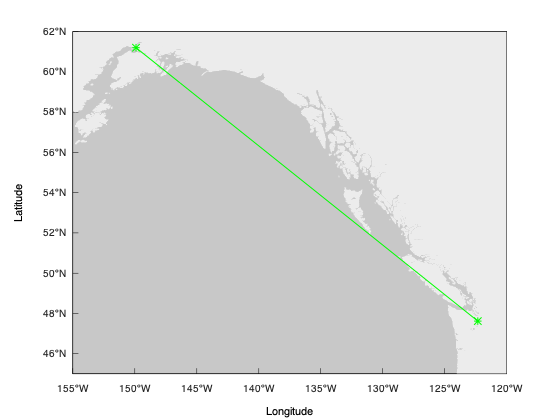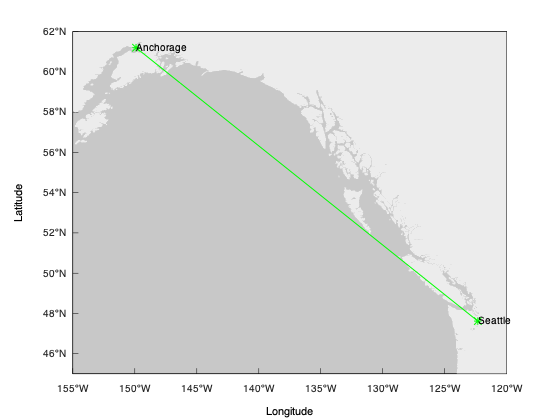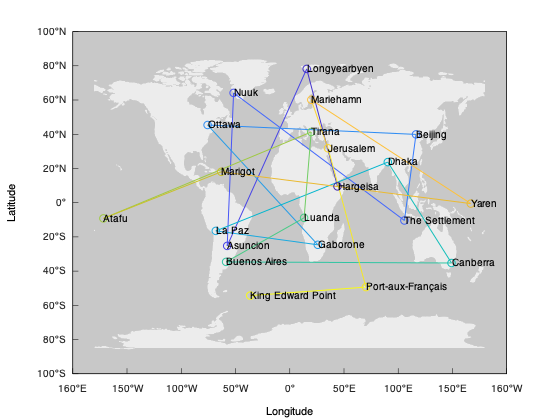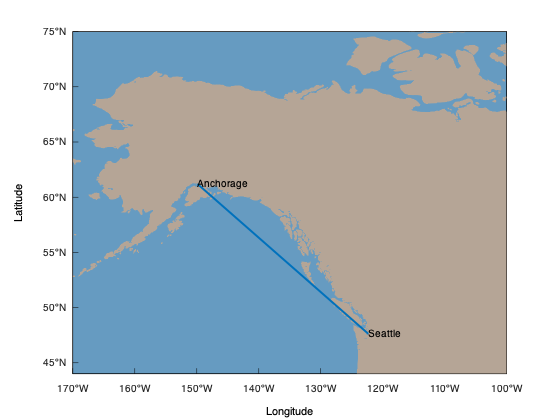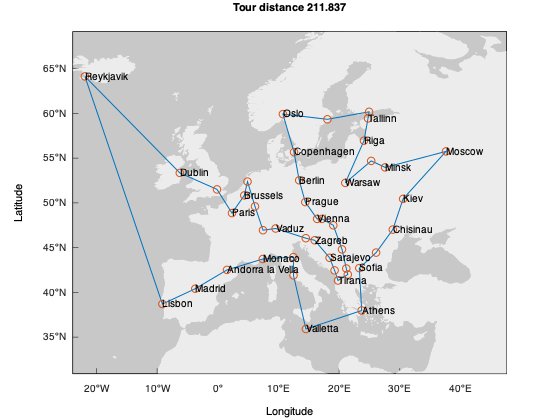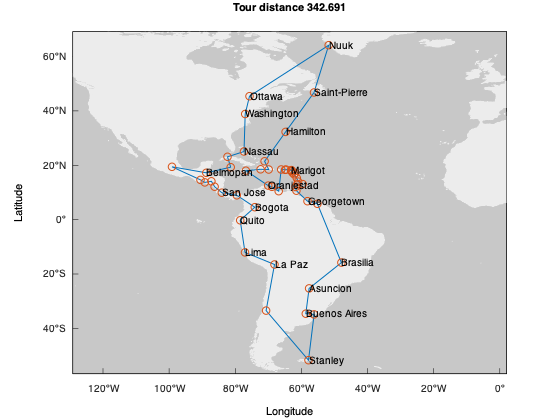1
2
3
4
5
6
7
8
9
10
11
12
13
14
15
16
17
18
19
20
21
22
23
24
25
26
27
28
29
30
31
32
33
34
35
36
37
38
39
40
41
42
43
44
45
46
47
48
49
50
51
52
53
54
55
56
57
58
59
60
61
62
63
64
65
66
67
68
69
70
71
72
73
74
75
76
77
78
79
80
81
82
83
84
85
86
87
88
89
90
91
92
93
94
95
96
97
98
99
100
101
102
103
104
105
106
107
108
109
110
111
112
113
114
115
116
117
118
119
120
121
122
123
124
125
126
127
128
129
130
131
132
133
134
135
136
137
138
139
140
141
142
143
144
145
146
147
148
149
150
151
152
153
154
155
156
157
158
159
160
161
162
163
164
165
166
167
168
169
170
171
172
173
174
175
176
177
178
179
180
181
182
183
184
185
186
187
188
189
190
191
192
193
194
195
196
197
198
199
200
201
202
203
204
205
206
207
208
209
210
211
212
213
214
215
216
217
218
219
220
221
222 | #include <matplot/matplot.h>
#include <random>
using namespace matplot;
using namespace std;
class americas_trip_solver {
public:
americas_trip_solver(const vector<double> &lat, const vector<double> &lon,
const vector<string> &names, axes_handle ax);
void run(size_t iterations = 100);
private:
void setup_axes();
void setup_starting_point(size_t iteration);
double tour_distance(const vector<size_t> &tour);
void iteration();
static vector<vector<size_t>>
get_neighbors(const std::vector<size_t> &tour);
bool update_if_better(const vector<size_t> &neighbor);
void draw_if_improvement();
void draw();
private:
vector<double> lat_;
vector<double> lon_;
vector<string> names_;
axes_handle ax_;
line_handle lh_;
// Current tour
double curr_dist_{0.0};
vector<size_t> curr_tour_;
// Best tour
double min_dist_{0.0};
vector<size_t> best_tour_;
};
americas_trip_solver::americas_trip_solver(const vector<double> &lat,
const vector<double> &lon,
const vector<string> &names,
axes_handle ax)
: lat_(lat), lon_(lon), names_(names), ax_(ax) {
setup_axes();
}
void americas_trip_solver::run(size_t iterations) {
for (size_t i = 0; i < iterations; ++i) {
setup_starting_point(i);
iteration();
}
ax_->draw();
ax_->parent()->save("americastrip.svg");
}
void americas_trip_solver::setup_starting_point(size_t iteration) {
std::cout << "Starting point " << iteration << std::endl;
if (iteration < names_.size()) {
auto [lon_ignore, lat_ignore, tour] =
greedy_tsp_with_idx(lon_, lat_, iteration);
(void) lon_ignore;
(void) lat_ignore;
curr_tour_ = tour;
curr_dist_ = tour_distance(curr_tour_);
} else {
static std::mt19937 g((std::random_device())());
std::iota(curr_tour_.begin(), curr_tour_.end(), 0);
std::shuffle(curr_tour_.begin(), curr_tour_.end(), g);
curr_dist_ = tour_distance(curr_tour_);
}
if (iteration == 0 || curr_dist_ < min_dist_) {
best_tour_ = curr_tour_;
min_dist_ = curr_dist_;
}
}
vector<vector<size_t>>
americas_trip_solver::get_neighbors(const std::vector<size_t> &tour) {
vector<vector<size_t>> neighbors;
constexpr size_t n_movements = 2;
for (size_t i = 0; i < tour.size() - 1; ++i) {
for (size_t j = i + 1; j < tour.size(); ++j) {
for (size_t movement = 0; movement < n_movements; ++movement) {
vector<size_t> neighbor = tour;
if (movement == 0) {
std::swap(neighbor[i], neighbor[j]);
} else {
std::reverse(neighbor.begin() + i,
neighbor.begin() + j + 1);
}
neighbors.emplace_back(neighbor);
}
}
}
return neighbors;
}
void americas_trip_solver::iteration() {
bool improvement = true;
while (improvement) {
improvement = false;
for (const auto &neighbor : get_neighbors(curr_tour_)) {
improvement = update_if_better(neighbor);
draw_if_improvement();
if (improvement) {
break;
}
}
}
}
double americas_trip_solver::tour_distance(const vector<size_t> &tour) {
double sum = 0.;
for (size_t i = 0; i < tour.size() - 1; ++i) {
sum += distance(lon_[tour[i]], lat_[tour[i]], lon_[tour[i + 1]],
lat_[tour[i + 1]]);
}
sum += distance(lon_[tour[tour.size() - 1]], lat_[tour[tour.size() - 1]],
lon_[tour[0]], lat_[tour[0]]);
return sum;
}
void americas_trip_solver::draw() {
vector<double> sorted_lat;
vector<double> sorted_lon;
for (const size_t &idx : best_tour_) {
sorted_lat.emplace_back(lat_[idx]);
sorted_lon.emplace_back(lon_[idx]);
}
sorted_lat.emplace_back(lat_[best_tour_[0]]);
sorted_lon.emplace_back(lon_[best_tour_[0]]);
lh_->x_data(sorted_lon);
lh_->y_data(sorted_lat);
ax_->title("Tour distance " + num2str(min_dist_));
ax_->draw();
}
bool americas_trip_solver::update_if_better(const vector<size_t> &neighbor) {
double d = tour_distance(neighbor);
if (d < curr_dist_) {
curr_tour_ = neighbor;
curr_dist_ = d;
if (d < min_dist_) {
best_tour_ = curr_tour_;
min_dist_ = d;
}
return true;
}
return false;
}
void americas_trip_solver::draw_if_improvement() {
static auto last_draw =
chrono::high_resolution_clock::now() - chrono::seconds(1);
static auto min_dist_when_last_draw = min_dist_;
const auto current_time = chrono::high_resolution_clock::now();
const bool its_been_a_while = current_time - last_draw > chrono::seconds(1);
const bool things_are_better = min_dist_ < min_dist_when_last_draw;
if (its_been_a_while && things_are_better) {
last_draw = current_time;
min_dist_when_last_draw = min_dist_;
draw();
}
}
void americas_trip_solver::setup_axes() {
ax_->clear();
ax_->geolimits(min(lat_) - 5, max(lat_) + 5, min(lon_) - 30,
max(lon_) + 50);
lh_ = ax_->geoplot(lat_, lon_);
ax_->hold(true);
ax_->geoscatter(lat_, lon_);
auto [lon_c, lat_c, names_c] =
clear_overlapping_labels(lon_, lat_, names_, 2, 2);
ax_->text(lon_c, lat_c, names_c);
ax_->draw();
}
int main() {
vector<string> names = {
"Marigot", "The Valley", "Saint John's", "Buenos Aires",
"Oranjestad", "Nassau", "Bridgetown", "Belmopan",
"Hamilton", "La Paz", "Brasilia", "Road Town",
"Ottawa", "George Town", "Santiago", "Bogota",
"San Jose", "Havana", "Willemstad", "Roseau",
"Santo Domingo", "Quito", "San Salvador", "Stanley",
"Nuuk", "Saint George's", "Guatemala City", "Georgetown",
"Port-au-Prince", "Tegucigalpa", "Kingston", "Mexico City",
"Plymouth", "Managua", "Panama City", "Asuncion",
"Lima", "San Juan", "Gustavia", "Basseterre",
"Castries", "Saint-Pierre", "Kingstown", "Philipsburg",
"Paramaribo", "Port of Spain", "Grand Turk", "Washington",
"Montevideo", "Caracas", "Charlotte Amalie"};
vector<double> lat = {
18.0731, 18.2166, 17.1166, -34.5833, 12.5166, 25.0833, 13.1,
17.25, 32.2833, -16.5, -15.7833, 18.4166, 45.4166, 19.3,
-33.45, 4.6, 9.9333, 23.1166, 12.1, 15.3, 18.4666,
-0.2166, 13.7, -51.7, 64.1833, 12.05, 14.6166, 6.8,
18.5333, 14.1, 18, 19.4333, 16.7, 12.1333, 8.9666,
-25.2666, -12.05, 18.4666, 17.8833, 17.3, 14, 46.7666,
13.1333, 18.0166, 5.8333, 10.65, 21.4666, 38.8833, -34.85,
10.4833, 18.35};
vector<double> lon = {
-63.0822, -63.0500, -61.8500, -58.6666, -70.0333, -77.3500, -59.6166,
-88.7666, -64.7833, -68.1500, -47.9166, -64.6166, -75.7000, -81.3833,
-70.6666, -74.0833, -84.0833, -82.3500, -68.9166, -61.4000, -69.9000,
-78.5000, -89.2000, -57.8500, -51.7500, -61.7500, -90.5166, -58.1500,
-72.3333, -87.2166, -76.8000, -99.1333, -62.2166, -86.2500, -79.5333,
-57.6666, -77.0500, -66.1166, -62.8500, -62.7166, -61.0000, -56.1833,
-61.2166, -63.0333, -55.1666, -61.5166, -71.1333, -77.0000, -56.1666,
-66.8666, -64.9333};
figure_handle f = figure(true);
americas_trip_solver s(lat, lon, names, f->current_axes());
s.run();
show();
return 0;
}
|
and
axis.
and
axes. The
